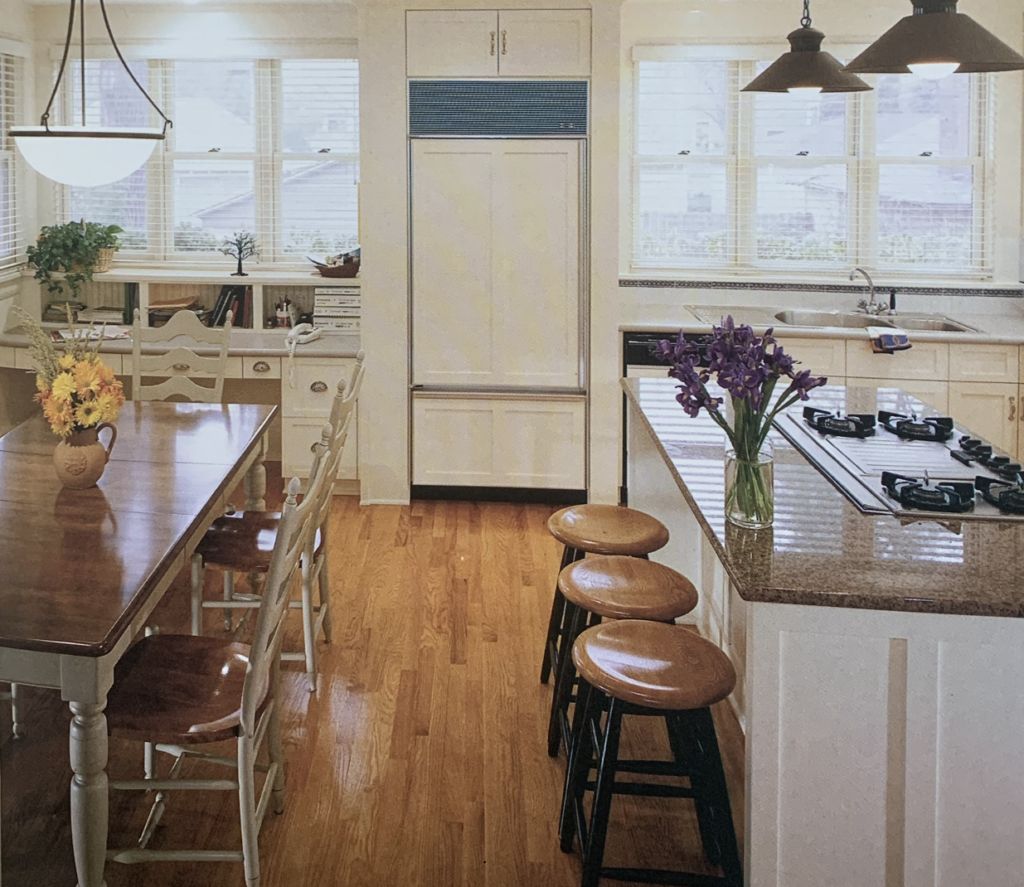Kitchen design according to Susan Susanka
Introduction

Kitchen design: As someone who has always been fascinated by home design, I was excited to read Sarah Susanka’s “The Not So Big House,” a book that emphasizes the importance of quality over quantity in home design. One of the main takeaways from the book is the idea that smaller homes can be just as functional and beautiful as larger ones. This principle applies to every part of the house, including the kitchen, which is often considered the heart of the home. In this article, I will explore the key principles of kitchen design in smaller homes, as well as provide tips and examples from “The Not So Big House.”
Key Considerations in Kitchen Design
Designing a kitchen in a smaller space requires a different approach than designing a larger one. One of the most important considerations is the layout of the kitchen. The kitchen triangle, which includes the stove, sink, and refrigerator, is a classic design principle that ensures the most efficient use of space. In a small kitchen, it is essential to keep the kitchen triangle as compact as possible while still allowing for ease of movement. The layout should also allow for ample counter space and storage, which can be a challenge in a smaller kitchen.
Another important consideration is the overall style and aesthetic of the kitchen. In a smaller space, it is essential to choose materials and finishes that are both functional and stylish. For example, choosing lighter colors and reflective surfaces can help create the illusion of more space. Additionally, incorporating natural light into the design can help make the kitchen feel brighter and more spacious.
Importance of Kitchen Layout
The layout of the kitchen is perhaps the most critical aspect of kitchen design in a smaller home. As mentioned earlier, the kitchen triangle is a classic design principle that ensures the most efficient use of space. In a smaller kitchen, it is essential to keep the kitchen triangle as compact as possible while still allowing for ease of movement. The layout should also allow for ample counter space and storage, which can be a challenge in a smaller kitchen.
One way to maximize storage in a small kitchen is to use every inch of available space. For example, you can install cabinets that go all the way up to the ceiling, or use the space under the sink for storage. Another option is to use open shelving, which can make the kitchen feel more spacious while still providing ample storage.
Kitchen Design Trends
In recent years, there has been a trend towards minimalist and modern kitchen design. This trend is especially relevant in smaller homes, where a cluttered or overly ornate design can make the space feel cramped. Simple, clean lines and neutral colors are popular choices for a modern kitchen. Additionally, incorporating natural materials such as wood or stone can add warmth and texture to the space.
Another trend in kitchen design is the use of smart technology. While this may not be as relevant in a smaller home, incorporating smart appliances and fixtures can help maximize space and efficiency. For example, a refrigerator with a built-in water dispenser can eliminate the need for a separate water filter, saving valuable counter space.
Tips for Designing the Perfect Kitchen in a Smaller Space
When designing a kitchen in a smaller space, there are several tips and tricks that can help maximize functionality and style. One of the most important tips is to keep the design simple and streamlined. This means choosing a minimalist aesthetic, using reflective surfaces to create the illusion of more space, and incorporating natural light.
Another useful tip is to choose multi-functional appliances and fixtures. For example, a sink with a cutting board can save counter space, while a range with a built-in ventilation system can eliminate the need for a separate hood.
Finally, it is essential to prioritize storage in a small kitchen. This means using every inch of available space, including under the sink, above the cabinets, and on the walls. Using open shelving instead of cabinets can also help make the space feel more open and airy.
Materials and Finishes for a Functional and Stylish Kitchen
Choosing the right materials and finishes is essential for creating a functional and stylish kitchen in a smaller home. One of the most popular choices for a modern kitchen is quartz, which is durable, low-maintenance, and available in a wide range of colors and patterns. Another popular material is stainless steel, which is sleek, modern, and easy to clean.
When it comes to finishes, matte and satin finishes are becoming increasingly popular for kitchen appliances and fixtures. These finishes are less reflective than traditional chrome or polished finishes, which can help make the space feel more subtle and understated.
Storage Solutions for a Small Kitchen
Maximizing storage is essential in a small kitchen. One of the most effective ways to do this is to use every inch of available space. This means installing cabinets that go all the way up to the ceiling, using the space under the sink for storage, and incorporating open shelving.
Another useful storage solution is to use pull-out drawers and shelves. These can be installed in cabinets to maximize storage space and ensure that everything is easily accessible. Additionally, incorporating a pantry or tall cabinet can help free up counter space while providing ample storage for food and appliances.
Appliances and Fixtures for a Compact Kitchen
Choosing the right appliances and fixtures is essential for creating a functional and efficient kitchen in a smaller home. One of the most important considerations is size. Choosing compact appliances and fixtures can help maximize counter and storage space while still providing all the necessary features.
Another important consideration is efficiency. Choosing appliances and fixtures with high energy ratings can help reduce energy costs and minimize the impact on the environment. Additionally, incorporating smart technology can help maximize efficiency and convenience.
Examples of Well-Designed Kitchens in “The Not So Big House”
“The Not So Big House” provides several examples of well-designed kitchens in smaller homes. One example is a kitchen with a compact layout that includes a sink, stove, and refrigerator in a tight triangle. The kitchen also features ample counter space and storage, including open shelving and a pantry.
Another example is a kitchen that incorporates natural light and materials to create a warm and inviting atmosphere. The kitchen features a large window that allows natural light to flood the space, as well as natural wood finishes and stone countertops.
See how one SketchList 3D user designed a contract winning kitchen.
Conclusion and Final Thoughts on Kitchen Design in Smaller Homes
Designing a kitchen in a smaller home requires a different approach than designing a larger one. Maximizing storage, incorporating multi-functional appliances and fixtures, and choosing the right materials and finishes are all essential considerations. Additionally, the layout of the kitchen is perhaps the most critical aspect of kitchen design in a smaller home. By following these principles and tips, it is possible to create a functional and stylish kitchen in even the smallest of spaces.

